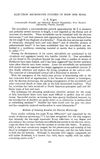TLDR Researchers found genes for cysteine-rich proteins that form the protective layer of hair in humans and sheep.
The study characterized two evolutionarily conserved genes encoding ultra-high-sulfur (UHS) keratin proteins, one from human hair follicles and one from sheep wool follicles. These proteins, each 16 kD and containing over 50 cysteine residues, were identified as being highly cysteine-rich (31-36 mol%) and composed mainly of cysteine-rich and glycine-rich repeats. The genes were expressed specifically in the hair cuticle at a late stage of follicle development, as shown by tissue in situ hybridization. Genomic analysis revealed that these UHS keratin proteins are encoded by related multigene families in both human and sheep genomes.
93 citations
,
May 1990 in “The EMBO Journal” Mice with extra sheep genes had hair that fell out and regrew in cycles.
38 citations
,
February 1989 in “Journal of Investigative Dermatology”  191 citations
,
November 1959 in “Annals of the New York Academy of Sciences”
191 citations
,
November 1959 in “Annals of the New York Academy of Sciences” Hair and wool have complex microscopic structures with microfibrils and varying cystine content.
January 2010 in “Acta Laboratorium Animalis Scientia Sinica” The UHS promoter is specific to mouse hair follicles.
73 citations
,
May 2009 in “Proceedings of the National Academy of Sciences” Disrupting the Sox21 gene in mice causes hair loss and regrowth cycles.
50 citations
,
July 2008 in “British Journal of Dermatology” 29 citations
,
April 2003 in “Experimental dermatology” Human hair follicles grown in vitro maintain normal keratin patterns and structure.
98 citations
,
December 1991 in “Annals of the New York Academy of Sciences” Keratin gene regulation is similar across mammals, affecting hair follicle differentiation.
67 citations
,
December 1990 in “The journal of cell biology/The Journal of cell biology” Researchers found genes for cysteine-rich proteins that form the protective layer of hair in humans and sheep.
7 citations
,
January 1988 42 citations
,
September 1985 in “British Journal of Dermatology” Trichothiodystrophy causes abnormal protein deposits and distortion in hair follicles.
